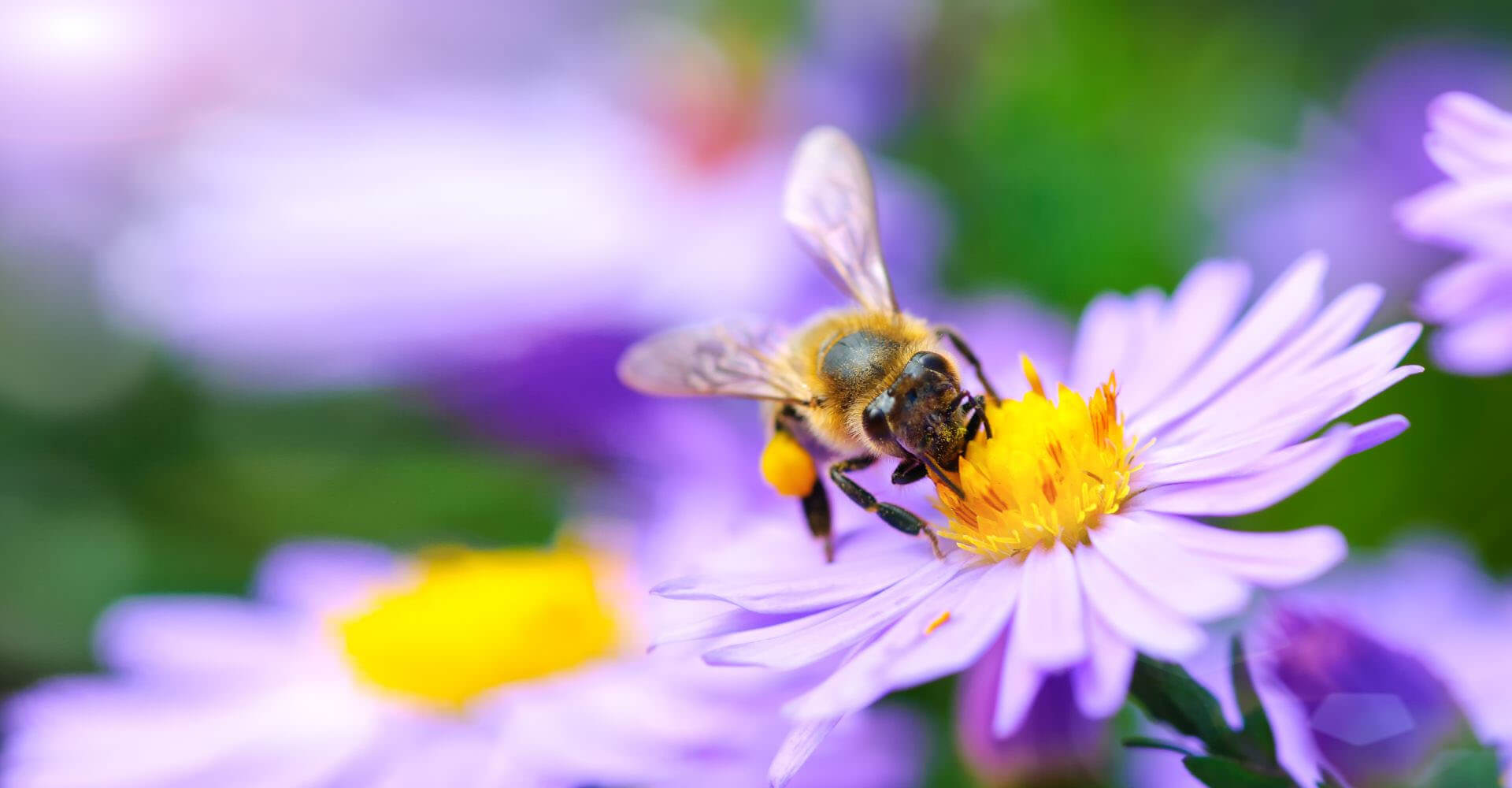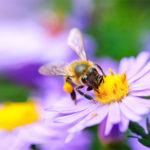
Bee-friendly plants: The best ideas for balconies and gardens!
What you can expect here
Bees, bumblebees and other insects such as butterflies lack natural habitat. Unfortunately, this also includes a lack of food, i.e. pollen and nectar. To help the little pollinators, we would like to show you here bee-friendly plants with which you can transform your garden, terrace or balcony into a beautiful bee paradise.
What’s the deal with bee-friendly plants anyway?
Why bee-friendly plants?
Worldwide, the number of bees has been declining for years. Besides pesticides, another reason is the reduction of their natural habitat. Colorful flower meadows, like the ones you’ve probably seen yourself, too often fall victim to industrial agriculture and construction to expand cities.
How can I help?
By planting bee-friendly plants on your patio, in your garden or on your balcony, you can at least do something to counteract these global developments. By planting bee-friendly plants, you can help other insects besides bees, such as beetles, wasps, butterflies, bumblebees and hoverflies. Bee-friendly plants are a small but very important contribution to environmental protection and nature conservation.
Not all plants are created equal
Large colorful flowers unfortunately do not yet guarantee the pollen and nectar that bees so desperately need. To help you find out in advance which perennials, shrubs, trees and flowers are really bee-friendly, we have compiled a wealth of tips and information for you here.
What makes plants bee-friendly?
If you’d like to incorporate bee-friendly plants into your outdoor space, it doesn’t matter which plants you choose. Flowers with heavily double blooms, typical balcony plants such as geraniums, look very pretty but don’t provide enough nectar or pollen for bees, butterflies or bumblebees. Bee-friendly plants have two important characteristics: they have a long flowering period, so they are available to insects for a long time, or they have a high content of pollen or nectar.
Properties of bee-friendly plants
Another important role is played by the structure of the flowers. Bee-friendly plants are characterized by wide-open and unfilled flowers. This ensures that both pollen and nectar are easily accessible to insects. Cultivated roses, for example, are often filled, which means that the many petals are close together, making it impossible for bees to reach the food.
Insects also have different tastes
Unfortunately, not all bee-friendly plants are equally suitable for all bee species. Honey bees are not particularly picky about what they eat. Wild bees in particular, however, are very specialized in this regard. Most insects are attracted to flowers that produce the most pollen. Good examples are especially plants from the umbelliferous and composite family. Butterfly flowers are special treats for the various wild bees with their very unique tastes. So you should put as many different plant species as possible in your garden. Below we introduce you to some plants whose seeds are also available online.
Bee-friendly plants: For garden, terrace & balcony
The willow
The willow scores with its early bloomer bonus. It starts blooming as early as March, providing bees with one of the few food sources in spring. You’ll find many different species of willow that vary widely. Our favorite is the Sal willow, as it is especially rich in pollen and nectar, and we have it to thank for willow catkins at Easter time. Willows are an important food source for bees and are a protected species. That is why in many places it is forbidden to cut the branches of the Sal willow from February to the end of April.
- Pollen: very high
- Nectar: high
- Flowering time: March to May
- Position: sun, partial shade
- Cultivation: calcareous, loamy, dry soil
- Habitat: garden
Blackberries & Raspberries
Snacking allowed! Blackberries and raspberries produce delicious berries and incidentally attract bees and other beneficial insects. You can also use them as privacy screens. They already bloom in May and are therefore also among the first important food sources in spring.
- Pollen: very high
- Nectar: very high
- Flowering time: May to August
- Position: sun
- Cultivation: nutrient rich soil
- Place: terrace and garden
Wild Vine
Wild vine is not only beautiful to look at, but also rich in nectar and pollen. It is ideal for growing over walls, fences, pergolas and trellises and can thus also serve as a natural privacy screen. Behind a fence overgrown with wild grapevine, you could enjoy yourself in a Hollywood swing. Wild vine is low-maintenance and therefore an ideal addition to your green paradise.
- Pollen: very high
- Nectar: high
- Flowering time: July to September
- Position: sun, shade, partial shade
- Cultivation: deep soil
- Place: terrace and garden
The apple tree
With an apple tree, you can add an irresistible bee magnet and juicy apples to your garden in one fell swoop. You’ve probably stood under an apple tree in the spring and been able to listen to the buzzing of the numerous bees in search of food, right? The blossoms of the apple tree are rich in nectar and pollen, and of course it also provides you with delicious apples from your own garden.
- Pollen: very high
- Nectar: very high
- Flowering time: April to May
- Position: sun
- Cultivation: deep, nutritious soil
- Place: garden
Phacelia
Phacelia is colloquially known as the “bee friend.” With its enormously high content of pollen and nectar, it also lives up to that name. Its beautiful purple flowers also make it a real eye-catcher. Unfortunately, the easy-to-care-for flower friend is only an annual, but it releases its previously collected nutrients during the rotting process, making it an excellent natural fertilizer for your other garden plants.
- Pollen: very high
- Nectar: very high
- Flowering time: June to September
- Position: sun
- Cultivation: loamy, fresh sandy soils
- Place: garden, possibly terrace
Snow heather
Snow or winter heather has pink, pink or white flowers that are filled to the brim with nectar and pollen. They provide a veritable buffet for insects from January through April. It is best planted in spring in a sunny or semi-shaded location with nutrient-rich, loose soil.
- Pollen: high
- Nectar: high
- Flowering time: January to April
- Position: sun, partial shade
- Cultivation: nutrient-rich, moist, loose soil
- Habitat: garden, pot on the terrace, certainly also in the balcony box
Clover
You’re probably already familiar with clover, right? You’ve probably also walked barefoot across a meadow and painfully realized how many bumblebees and bees are cavorting at the bottom. The pollen content of clover is very high, and it does not skimp on nectar either. Clover blooms from the beginning of May until September. Maybe you’ll even find a lucky four-leaf clover in your garden soon!
- Pollen: high
- Nectar: very high
- Flowering time: May to September
- Position: sun, partial shade
- Cultivation: nutrient-rich, calcareous soil
- Habitat: garden
Dandelion
No, we’re not recommending you get Peter Lustig in your garden. But it’s definitely worth planting dandelions. It usually grows in nutrient-rich pastures, meadows or along roadsides. The beautiful yellow flowers are full of important nectar for bees and other insects.
- Pollen: very high
- Nectar: very high
- Flowering time: April to June
- Position: sun
- Cultivation: nutrient-rich, deep soil
- Place: garden
Marigold
Marigolds are real multi-talents. They are super food sources for insects, edible and in addition as a medicinal plant can also be used as a decongestant, anti-inflammatory ointment, which is very easy to make yourself. Marigolds bloom from about May to September, are unfortunately only annuals, and come in beautiful shades of orange and yellow. Ideally, they stand in a sunny place with a loamy soil.
- Pollen: high
- Nectar: high
- Flowering time: May to September
- Position: sun
- Cultivation: loamy, sandy soil
- Place: garden, terrace, balcony
Sunflower
The sunflower is a real feast for the eyes and immediately beautifies your garden as a yellow-orange perennial. It also offers both a very high pollen and nectar content and is a bee favorite. As the name suggests, it does best in the sun in nutrient-rich, loamy soil.
- Pollen: very high
- Nectar: very high
- Flowering time: July to September
- Position: sun
- Growing: nutrient-rich, sandy-loamy soil
- Place: garden
Borage
Borage is an annual plant also known as “cucumber herb” because its edible and hairy leaves have a “cucumber” aroma. In addition to its “cucumber-like nature,” borage is notable for its nectar-rich, blue and pink star-shaped flowers. Borage is actually quite easy to care for, preferring a sunny or semi-shady spot in moist, well-drained soil. However, it quickly self-seeds.
- Pollen: high
- Nectar: very high
- Flowering time: June to September
- Position: sun, partial shade
- Cultivation: fresh, well-drained soil
- Habitat: garden, terrace, balcony
Buckwheat
Maybe you’ve had buckwheat pancakes before. Now you can bring this nectar-rich annual plant with its sweet white flowers into your garden. It’s fairly undemanding, needing a sunny or semi-shady spot in sandy, loose soil. After its decay you can use it as a natural fertilizer.
- Pollen: high
- Nectar: very high
- Flowering time: April to May
- Position: sun
- Cultivation: deep, nutritious soil
- Place: garden
Nasturtium
Nasturtiums are beautiful to look at with red, orange or yellow flowers and climbing varieties are ideal for growing along fences and trellises. They need a sunny to semi-shady location and nutrient-rich soil. Nasturtiums are very sensitive to frost, though, so you’re better off bringing them indoors in the winter. It is also edible, its flavor is intense and peppery, a bit spicier than garden cress. In addition, it is also suitable as a medicinal herb.
- Pollen: high
- Nectar: high
- Flowering time: July to September
- Position: sun, partial shade
- Growing: fresh, humus soil
- Habitat: garden, terrace, balcony
Catnip
If you have a cat, you can kill two birds with one stone. Your cat will certainly thank you. Catnip, also known as cat balm, has blue, white or blue-purple flowers and a rich supply of nectar. It blooms from May to August and loves sun and nutrient-rich soil. Catnip is not chaste and forms numerous seeds that can spread quickly. A little tip on the side: catnip is great as a natural remedy against mosquitoes, wasps, etc.
- Pollen: moderate
- Nectar: very high
- Flowering time: May to August
- Position: sun
- Growing: nutrient-rich, sandy-loamy soil
- Habitat: garden, terrace, balcony
Cornflower
You have certainly seen cornflowers before, they are often found along field edges and paths. They are not always just blue, but also come in white and pink. Cornflowers are summer annuals, bloom from June to September, and provide plenty of nectar for insects. They like sunny places with loamy soils. By the way, their flowers are also edible.
- Pollen: high
- Nectar: very high
- Flowering time: April to May
- Position: sun
- Cultivation: loamy soil
- Habitat: garden, terrace, balcony
Mallow
Mallows come in many different types and colors. Tall hollyhocks are especially well known, but there are many other varieties that bloom white, pink, pink or yellow. They offer a lot of nectar and are therefore great for insects.
- Pollen: moderate
- Nectar: very high
- Flowering time: July to September
- Position: sun
- Cultivation: nutrient-rich, well-drained soil
- Habitat: garden
Perennial herbs
Perennial herbs are ideal for gardens, patios and balconies. Rosemary blooms as early as spring, sage blooms throughout the summer, and lavender not only smells good, but is a real bee magnet. We especially like the versatility of perennial herbs, as many of them are edible or can be used in other ways. Small pots of herbs also look extremely good at garden parties, when each guest can pick their own spices.
- Pollen: high
- Nectar: high
- Flowering time: variable, about March to October
- Position: sun
- Cultivation: loamy, dry soil
- Place: garden, terrace, balcony
Tips for a bee-friendly balcony
Insect paradise on the balcony
If you’re into colorful flowers, you can get a wildflower mix and sow them in large balcony boxes, pots or containers. There are extra “bee-friendly” flower mixes that are inexpensive, pretty, pleasantly fragrant, and bee food sources at the same time. For the colder seasons and transitional times, ivy is a good choice and you can plant it along flower grates or walls.
Bee-friendly coziness
It’s easy to help the bees outside your window. For example, in addition to bee-friendly plants, you can put up a “nesting aid.” “Nesting aids” are easy to install on a balcony or next to a window ledge. “Wild bee hotels” are also easy to build yourself or buy ready-made. Bees especially like to nest in these hotels if your bee-friendly herbs and flowers are nearby.
Herbs, herbs, herbs!
Herb pots, for example, in your vegetable garden filled with kitchen herbs such as mint, basil, borage, chives, lemon balm, thyme, cilantro and sage are not only good for enhancing your meals, but are also a good food source for bees. You can also stick so-called cut “pith stems” between your flowers and herbs. The “pith stems” are natural nesting sites for wild bees and are very easy to add.
The bee drinker: thirst quencher for insects
Of course, bees need water in addition to pollen and nectar as food. Much of their water needs are met by nectar, but bees also use water to cool their hives on particularly hot days. So it’s a good idea to offer the insects a watering hole as well.
Make your own bee watering trough
Usually, bees collect water at the edge of puddles, in the form of morning dew from grass, or on the shores of ponds and lakes. If there is no natural water source nearby, you can step in and help them. If you want to build a watering hole for the bees at your place, you should read on now. Basically, it’s really child’s play: you decide on the shallowest possible bowl or dish, then add some water – and you’re done! So there’s no need for a watering computer or anything similarly complex. Now you can start with the design. To prevent the bees from drowning, you should place a board, stones or moss in the bowl. Set up a little bathing place for the bees!
Bees are non-swimmers
Bees can’t swim, so be sure to create shallow access to the water. For example, you can lay out flat pieces of wood, marbles or stones. This will not only create a practical landing area for the insects, but it will also look very decorative.
Designing the bee trough
The possibilities for designing your bee watering hole are virtually endless. For example, you can install small patches of moss, because they store water and can release it again. Wood or cork pieces on which the bees can land are also suitable. With stones and gravel you can build small islands in the water.
What you should keep in mind
It is best to place your bee watering trough near your bee-friendly plants, i.e. close to flower beds or flower boxes. It is best placed in a warm, sunny, windless location. Also, you should really ONLY put water in the waterer. Please do not put sugar or honey in it. You should also change the water regularly and keep refilling it so that the bees get enough water. If you follow these basics, you can ensure the well-being of the bees near you even on warm days.
Final words
Whether you have a large garden, a balcony, or a patio, anyone can take action and take action against bee mortality. You can find more information about the topic and bee-friendly plants in the extensive bee encyclopedia of the Federal Ministry of Food and Agriculture. If you have any questions, we will be happy to help you in the comments section.





